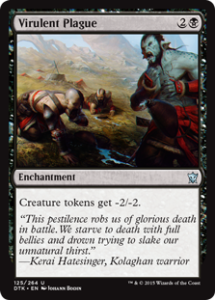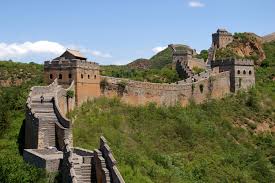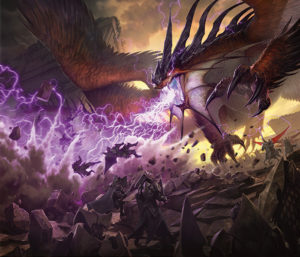“Abzan, Jeskai, Sultai, Mardu, Temur – names lost to history, yet worthy of further study.” – Narset, on [casthaven]Tapestry of the Ages[/casthaven].
The world that once was home to the khans and their warring factions is no more. Now, the timeline and political landscape of Sarkhan’s birth is the “Unwritten” Tarkir, supplanted by a world ruled by dragons each of which excised one mana color from the identity of their respective clan. The Dromoka, Ojutai, Silumgar, Kolaghan, and Atarka have existed since time immemorial and will always remain. The Khans of Tarkir were wholly annihilated by dragonkind.
So what happened on Earth?
No, not dragons.
A territory as vast as the unitary Empire simply could not remain whole forever. After Chinggis faded into sacred memory, his descendents found themselves flung far from the steppes of their cultural center, distant from the land of sacred spirits and holy rivers. Over time, they began to take upon the religions, cultures, and values of their conquered peoples, becoming rulers of distinct regional dynasties rather than aloof foreign overlords. Where they had once ridden as khans, the Mongol peoples now ruled as emperors, shahs, and tsars.
Eventually, even these ruling powers fell. We can see a good example in the creation of the Ming Dynasty in China. Outraged by widespread devastation, corruption, and tyrannical rule throughout China, a series of revolts against the Mongol Yuan Dynasty culminated in the rise of Zhu Yuanzhang (later, the Emperor Hongwu) as a peasant revolutionary and the fall of the final Mongol emperor in 1368.
Where they had once ridden as khans, the Mongol peoples now ruled as emperors, shahs, and tsars.
The Ming Dynasty immediately took upon re-establishing the cultural values of Han Chinese civilization, razing the Mongol palaces in present-day Beijing and constructing the Great Wall of China. As a military installation, the Wall was less than fully effective, but as a symbol of China’s separation from the Mongols who once conquered it, the message could not be more clear. Like the Ojutai on Tarkir, the newly-founded Chinese dynasty was eager to rid itself of unwanted influences and inheritance, which it castigated as heresy against the rightful order of the Chinese state.
 Eventually, few Mongol rulers remained beyond the steppes. Revolution, warfare, and political dissolution within the Mongol Empire undid each of the states that answered to Mongol authority. Finally, in the mid-14th century, an unseen enemy which no Mongol army could defeat traveled from the steppes, along the Silk Road, and into the hearts of cities around the world. The devastating Black Plague contributed to the demise of the unified Mongol governments in Eurasia.
Eventually, few Mongol rulers remained beyond the steppes. Revolution, warfare, and political dissolution within the Mongol Empire undid each of the states that answered to Mongol authority. Finally, in the mid-14th century, an unseen enemy which no Mongol army could defeat traveled from the steppes, along the Silk Road, and into the hearts of cities around the world. The devastating Black Plague contributed to the demise of the unified Mongol governments in Eurasia.
Some would lay claim to the legacy of Chinggis Khan to legitimize their own conquest and rule, such as Tamerlane, a nomadic Turkish warlord in the 14th century. But the medieval Mongols, like the ancient cultures of Tarkir, left few written documents of their rise and reign. Most of what we know about the age of khans stems from the words of their subject peoples, who came from agricultural societies that prized record-keeping and written documentation.
Like the whispers of the once-Temur shamans, the legacy of the Mongols remained. Oral histories of the Mongol peoples preserved Chinggis Khan as a mighty figure to be feared and venerated, an protective ancestral spirit for his peoples into the modern day. The brutal legacy of Mongol conquests shaped the landscape of central Asia, erasing cities ravaged by war and subsequent famine and thrusting others (like the city known today as Beijing) into greater prominence.
Like the whispers of the once-Temur shamans, the legacy of the Mongols remained.
The Silk Road endured, in history and in memory. Perhaps the greatest achievement of the Mongol Khans, it remained a fabled source of wealth and power, a leyline of trade that spanned the entire world. With the rise of the Ottoman Empire in the eastern Mediterranean world, European powers inspired by the account of Marco Polo could no longer fund journeys overland to the realm of Khubilai Khan. Instead, they turned to the sea, hoping to find an unguarded route to wealth and trade. Inspired in part by the tales of Mongol riches and imperial might recounted by Marco Polo, a Genoese explorer named Cristoforo Colombo took to sea and landed on the outlying islands of the Americas in 1492.
It is hard to tell what Tarkir’s present, with Ugin and the reign of dragons, will borrow from medieval Mongol mythology and history. Tarkir is now shaped by the rule of dragons more than the history of the Khans, and as such does not so closely resemble the powers of the medieval world.
The Kolaghan have lost the white-aligned discipline and central authority that allowed the Mardu and its Earth-history corollary to conquer the world. The Atarka no longer venerate and contemplate the spirits and animals as they once did, spending every moment in service to ravenous dragons. The ancestor worship of the Abzan, borrowed from Mongol tradition, is outlawed, as are the anti-authority strains of the red-aligned Jeskai. The Rakshasa and Naga of the Sultai still remain under Silumgar, but their exalted place is usurped by the spiteful blue-black dragonlord.

Although only sorta visible from space, the Great Wall demonstrates just how determined Ming China and other empires were to push out Mongol invaders and their legacy.
Ultimately, it will be interesting to see how this new world order reflects Mongol culture from the ancient clans. Narset is clearly intent upon discovering more about the Unwritten Tarkir, despite Sarkhan’s delight at a plane of mighty dragonlords. And others, like the hidden shamans under Atarka and the martyred Anafenza, maintain cultural traditions passed down in secret. The way of the Khans will remain in some form in the Tarkir of Dragons, but in either case, it has been an absolute delight to see Wizards put so much effort into portrayals of historical cultures and religions to build their latest set.
Join me next week, as we start to look forward to future sets and make completely unfounded predictions based on history!
Curtis Wiemann still honors the khans.


